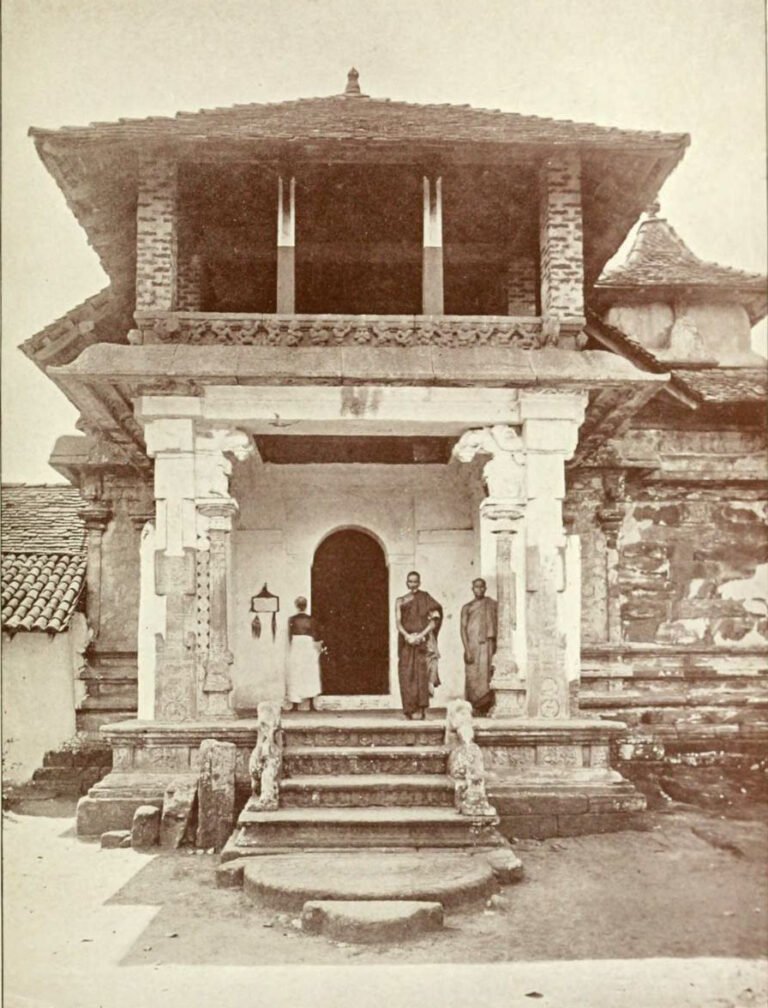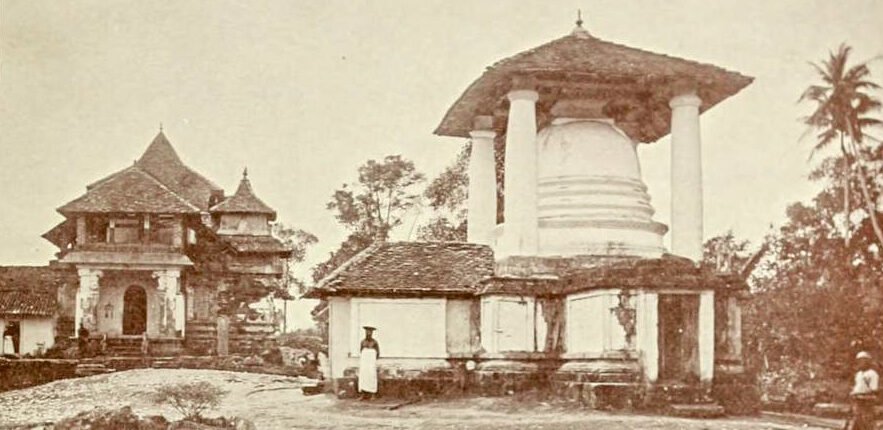History and Importance
Introduction
Gadaladeniya Sri Saddharmatilaka Rājamahā Vihāra, situated atop the rock formerly known as “Diggal Atala,” is a significant historical and cultural landmark in Sri Lanka. This temple, constructed in the early fourteenth century, is a testament to the religious and cultural exchanges between India and Sri Lanka. Its unique origins and architectural marvels make it stand out among ancient Buddhist shrines in the country.
Names and Evolution
The temple has been known by various names throughout history, including “Dharmakīrti Vihāra,” “Saddharmatilaka Vihāra,” and “Gadaladeniya.” Today, it is known as “Gadaladeniya Sri Saddharmatilaka Rājamahā Vihāra.”

19th cenctury
Tectural Significance
Gadaladeniya Vihara represents a significant historical milestone as the only Buddhist shrine built through the cooperation of Dravidian and Sinhalese communities. The temple’s design reflects a harmonious blend of South Indian Dravidian and Sri Lankan architectural styles, showcasing intricate carvings emblematic of both traditions. The temple, constructed entirely from granite, is a unique feature in Sri Lankan Buddhist architecture. Its meticulous design and intricate stonework highlight the fusion of South Indian and Sri Lankan architectural elements.
Recognizing its historical and archaeological importance, the Gadaladeniya Vihara was designated as a protected archaeological monument by Gazette No. 10928 dated 11.05.1956.
Historical Background
The construction of Gadaladeniya Vihara was a collaborative effort led by Venerable Dharmakīrti I during the reign of King Bhuvanekabāhu IV. Dharmakīrti I, a revered figure in Sri Lankan Buddhism, engaged in extensive Buddhist missionary activities in India, which culminated in the construction of the Gadaladeniya temple. He invited the Dravidian architect Ganeṣvarācāri from Andhra Pradesh, South India, to Sri Lanka, where nearly a thousand Dravidian artisans worked alongside local Sri Lankan architects.
The temple’s construction was generously supported by the king, members of the royal family, ministers, government officials, and both Sinhalese and Tamil communities. The temple, boasting three stories, was crafted with meticulous attention to detail, featuring intricate depictions of Buddha and celestial beings. Contributions from individuals and groups were instrumental in bringing this vision to fruition, reflecting deep devotion to Buddhist teachings and spiritual practice.
Religious and Historical Importance
Gadaladeniya Vihara holds paramount status among the Buddhist shrines of the Gampola era (14th century). It was the only temple where the four Sangharājas (supreme patriarchs) resided and served as the headquarters for the renowned “Dharmakīrti” monastic lineage. The temple played a crucial role in Buddhist activities during the Kingdoms of Gampola, Kotte, Sitawaka, and Senkadagala (Kandy).

19th cenctury
The title of “Sangharāja” or “Mahasāmi” represented the highest position within the Buddhist monastic community of Sri Lanka. Historically, the temple where the Sangharāja resided held immense importance, attracting regular visits from reigning monarchs seeking counsel.
Contributions and Renovations
Throughout various reigns, the temple received offerings and support from royals. King Bhuvanekabāhu IV contributed to the temple’s construction, while King Parakramabāhu V renovated the pagoda named “Vijayotpāya.” Queen Hena Kanda Biso Bandāra donated several lands to the temple. Other dignitaries, including Senādhilankāra alias Senālankādhikāra and King Parakramabāhu VI of the Kingdom of Kotte, played significant roles in supporting and restoring the temple.
During the Portuguese invasion in the 15-16th centuries, the temple suffered significant losses, including the theft of valuable artifacts and damage to sacred imagery. Subsequent kings, such as King Senāsammata Vickramabāhu, Sri Vīra Parākrama Narendrasingha, and King Kīrthi Sri Rājasingha, contributed to the temple’s restoration and enhancement.
Literary and Educational Contributions
Gadaladeniya Vihara has been a hub of Sinhalese literature. Renowned Sri Lankan literary works such as Janānurāga Caritaya, Pāramī Mahā Sataka, Nikāya Sangrahaya, Saddharmālankaraya, Saddharmaratnākaraya, Jinabodhāvalī, and the renowned Gadaladeni translation of Pāli Bālavatāra were authored by monks of the Dharmakīrti lineage. Venerable Welivita Sri Saranankara Sangharāja established a Buddhist monastic institution called “Sri Dharmakīrti Pirivena” within the temple premises, providing education to numerous lay students and contributing to the foundation of modern Buddhist monastic education in the early 18th century.
The Dharmakīrti Lineage
The Dharmakīrti lineage, stemming from Venerable Dharmakīrti I, has played a profound role in shaping Sri Lanka’s Buddhist heritage and literary tradition. This lineage can be traced back to the Polonnaruwa era (11th century) with Venerable Palābadgala Dharmakīrti Sangharāja. The lineage continued to make commendable contributions to the advancement of Sri Lankan Buddhism, literature, and philology during the Gampola and Kotte Kingdoms.

19th cenctury
Architectural Significance
The Gadaladeniya Vihara, designed according to the architectural style of ancient Dravidian Hindu shrines, particularly reflects South Indian architecture. Archaeological investigations have unveiled that the temple’s architecture seamlessly merges South Indian architectural techniques with ancient Sri Lankan architectural traditions dating back to the Polonnaruwa era (11th century). This synthesis underscores the profound impact of Hinduism in Sri Lanka during the temple’s construction period.
